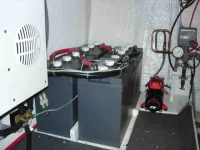egaito
Legendary Member
- Joined
- Jun 27, 2005
- Messages
- 1,153
- Status
- OWNER - I own a Hatteras Yacht
- Hatteras Model
- 41' CONVERTBLE-Series I (1964 - 1971)
Sanctuary is equipped with an engine mounted compressor and a tank on the wall, probably about 3 gallons, to run the horns.
The tank is of unknown age and condition. The system leaks down pretty quickly once the engine is shut of, so it's as good a time as any to look at the system as a whole.
I'm thinking of putting in an electric compressor, and a new tank, that will be large enough to run a few air tools, all falling into the 4-9 cfm range for flow requirements.
I have found several 2hp, 3 gallon compressors that put out 4-5cfm at about 90 psi, but can't find a calculator to see how much "duty time" that would offer an air tool that requires 6 cfm to run. I know, that the bigger the tank, the more reserve it provides, but does anyone know how to calculate the reserve/run times based on tank size?
Another thought is to use a component approach....compressor motor, mounted remotely from a larger tank. By larger, I'm speaking relatively of course, meaning larger than what's there, but I'm not trying to get an auto-body shop compressor and tank in the ER.
What have you guys seen or done? Any pictures or project notes?
The tank is of unknown age and condition. The system leaks down pretty quickly once the engine is shut of, so it's as good a time as any to look at the system as a whole.
I'm thinking of putting in an electric compressor, and a new tank, that will be large enough to run a few air tools, all falling into the 4-9 cfm range for flow requirements.
I have found several 2hp, 3 gallon compressors that put out 4-5cfm at about 90 psi, but can't find a calculator to see how much "duty time" that would offer an air tool that requires 6 cfm to run. I know, that the bigger the tank, the more reserve it provides, but does anyone know how to calculate the reserve/run times based on tank size?
Another thought is to use a component approach....compressor motor, mounted remotely from a larger tank. By larger, I'm speaking relatively of course, meaning larger than what's there, but I'm not trying to get an auto-body shop compressor and tank in the ER.
What have you guys seen or done? Any pictures or project notes?


